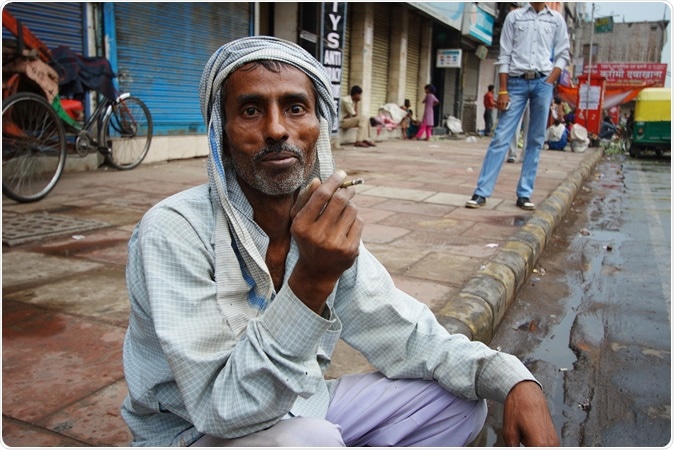The World Health Organization (WHO) has listed out 10 major threats to the health of majority of the global population in 2019. The problems range from communicable diseases such as measles and diphtheria that are vaccine preventable, to non communicable diseases such as heart disease, obesity, drug resistant microbes etc. This year 2019 is slated to be the start of the five-year plan from the organization to tackle these threats.

DELHI, INDIA - An unidentified man smokes a traditional "bidi" cigarette. India faces an epidemic of tobacco use, which is higher among impoverished classes. Image Credit: Dana Ward / Shutterstock
The 5 year strategic plan is called the 13th General Programme of Work or the 13th GPW.
Second on the list are non-communicable diseases including cancer, heart disease, stroke, diabetes etc. The WHO report states that around 70 percent of the deaths are caused by these non-communicable diseases. It kills around 41 million deaths around the world. Of these 15 million people who die prematurely of these diseases belong to age group of 30 to 69 years.
According to the WHO the main culprit behind these rising number of deaths due to non-communicable diseases alongside infectious diseases is the change in the lifestyle of the majority of the population. There is a stark rise in physical inactivity and sedentary life says the report. Tobacco use and alcohol abuse are other major contributors. Unhealthy diet and intake of sugar rich trans fat containing processed foods are responsible for rise in obesity across the globe and this leads to obesity related diseases such as diabetes, heart diseases, stroke, metabolic syndrome etc. These risk factors are also responsible for mental health disorders that are affecting a large proportion of the world population.
According to the report the baseline number of deaths attributed to non communicable diseases in 2018 is 20 percent. The WHO target is at 15.5 percent as part of the SDG. The target is a “20% relative reduction in the premature mortality (age 30-70 years) from NCDs (cardiovascular, cancer, diabetes, or chronic respiratory diseases) through prevention and treatment.”
The report says that the indicators they would use to assess progress over the 5 year plan are –
- “Probability of dying between the exact ages of 30 and 70 years from CVD, cancer, diabetes, or chronic respiratory diseases”
- “Mortality rate attributed to cardiovascular disease, cancer, diabetes or chronic respiratory disease”
- “Total net official development assistance to medical research and basic health sectors”
- “Proportion of health facilities that have a core set of relevant essential medicines available and affordable on a sustainable basis”
The SDG set by WHO for the 5 year term include;
- “By 2030, reduce by one third premature mortality from non-communicable diseases through prevention and treatment and promote mental health and well-being”
- “Support the research and development of vaccines and medicines for the communicable and non-communicable diseases that primarily affect developing countries, provide access to affordable essential medicines and vaccines...”